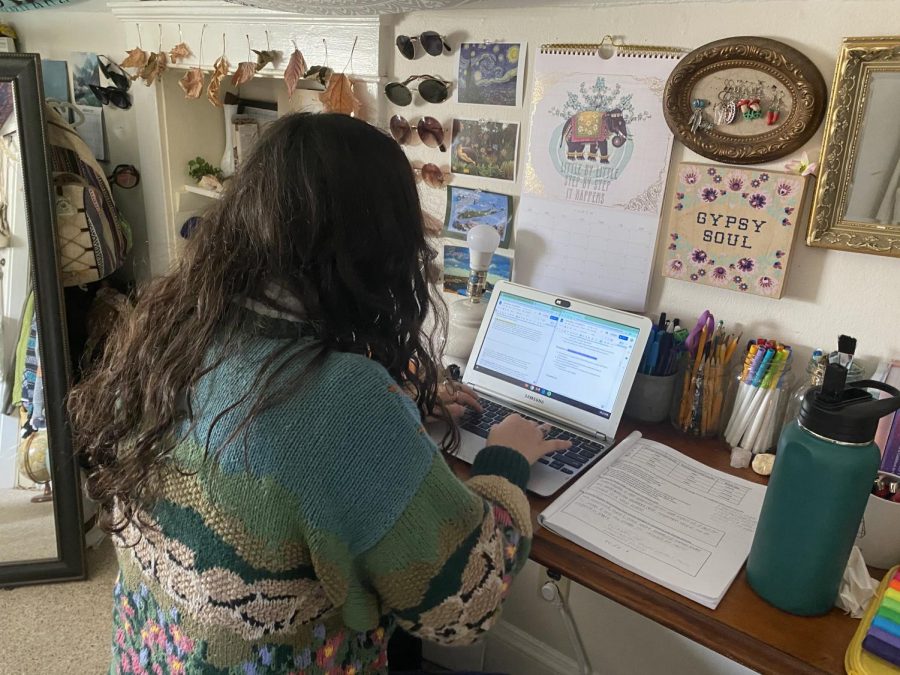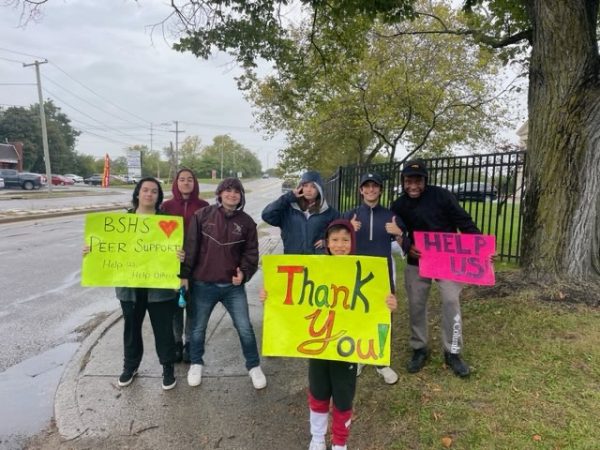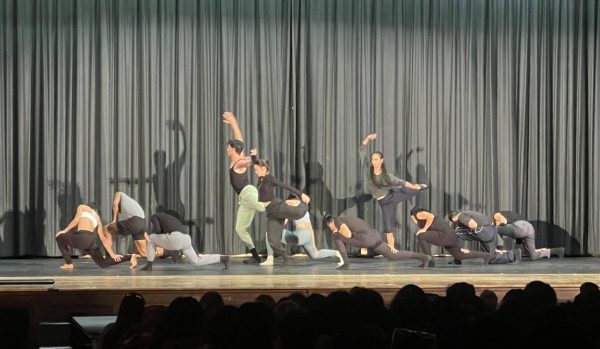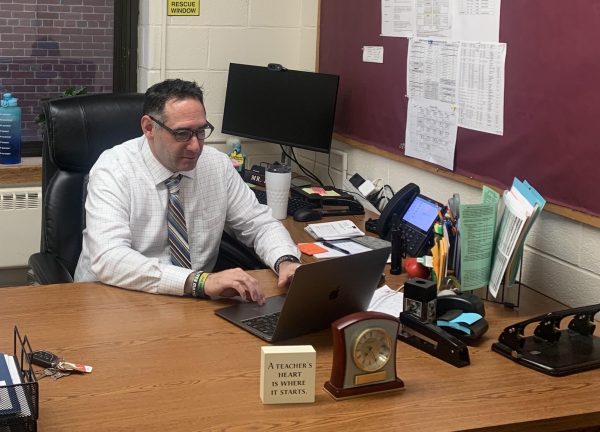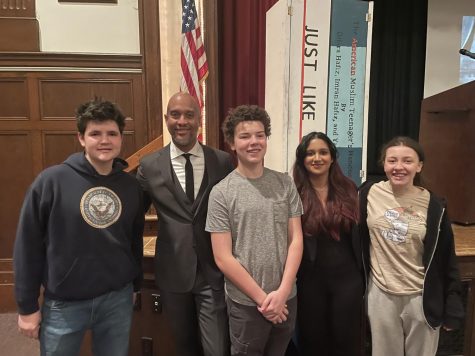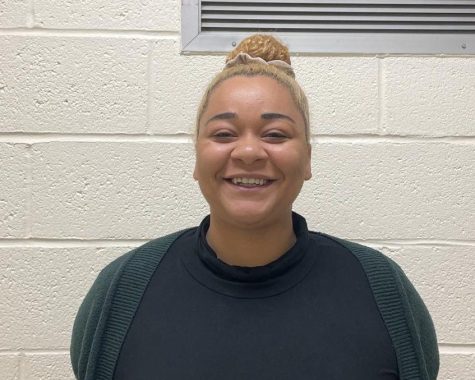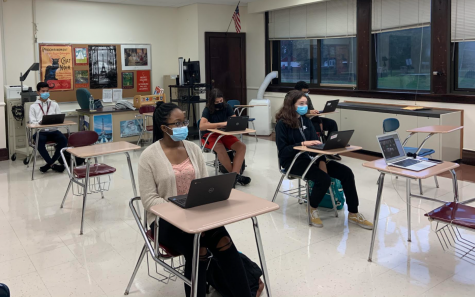Virtual learning – When staying home means you aren’t playing hooky
Photo by Lucia Milza Over 525 students are learning virtually this year as a result of the pandemic, according to guidance department figures. Virtual learners must sign in to their computers for class and remain in attendance, doing all the assignments from their own homes.
March 15, 2021
What once was a school day filled with students frantically scrambling at the sound of the bell now consists of Kaelyn Pellmen, junior, sitting at her desk, utterly alone.
With a simple click of a button, she’s ready to start the day with a bunch of icons (a.k.a. students) floating around her computer screen.
“Instead of waking up at six in the morning, I woke up Thursday, September 10 at 7:10 am, walked to my desk, and started my first day of school fully virtual,” said Pellmen. “I had a lot more distractions at home and was very stressed.”
At of the beginning of the 2020-2021 school year, the district proposed two alternatives to learning thanks to the pandemic. (To read about hybrid learning, click here) One option was virtual learning, where students are required to watch their teachers and fellow students in the high school – all from their homes. Approximately 525 students virtually attend school as of December 2020 according to figures provided by the guidance department.
“I decided to go completely remote for the first half of the school year because we were still in a state of the unknown with COVID and there are health issues in my family,” said Coltrane Calloway, senior. “I would never put us in a bad situation.”
At the beginning of the school year, 52 percent of US students attended school on an only-virtual basis, according to CNBC.
“When it comes to school, I still fear sending my child back every day,” said Linda McBride, parent of a senior. “The school has done everything they could to act according to the situation, following COVID restrictions and keeping our kids safe, but in my opinion, no “COVID norm” overcomes the fear of my child catching the virus.”
With some virtual students across the nation floundering academically, socially, and emotionally, the American Academy of Pediatrics is urging schools to prioritize in-person classes.
“I think kids have gotten a lot quieter and more distant from each other,” said Nikole Perez, sophomore. “School isn’t the same when your only way to interact is through a screen.”
While communication and engagement are key factors for student success in any classroom these variables play out differently in a virtual setting, according to Michigan Virtual, a non-profit focused on face-to-face, blended, and online learning innovations.
“Keeping an open source of communication is key,” said Carr. “I try – as best I can – to stay in touch with students who are struggling. Sometimes, just them knowing I am concerned can go a long way in helping them succeed.”
Instructors expressed displeasure with a general feeling of “talking to yourself” that occurs when students do not have their cameras on, according to a study in Ecology and Evolution. If instructors have a negative experience, they may do a poorer job teaching, the study found.
“Most students don’t put their camera on and we have no school policy for it,” said Alison Mauri, math teacher. “I cannot gauge if they understand something or not without seeing their face.”
Technology hasn’t been cooperative, either. Earlier in the year, there were connectivity issues throughout the district. At a November 2020 board of education meeting, it was revealed that a month earlier, the district was the target of an Internet attack that saw high levels of traffic from multiple foreign countries. The attack interrupted live-streaming session district-wide and, coincidentally, it ended by the final bell at the high school. Service has dropped since, but not to the level of these earlier events, thanks to increased Internet security.
“It’s a little annoying because then I’m missing what the teacher is talking about or if they are calling on me I won’t know,” Nicole Lepore, junior. “It usually doesn’t happen often, at most it’s once a week or once every two weeks.”
An estimated 10 million to 16 million students across the US lacked internet access before schools closed, according to Education Superhighway, and about 15 percent of students do not have a computer, based on a recent University of Southern California study. The high school was able to buck this trend as it was already in the middle of a 1-to-1 laptop distribution when the pandemic closed school. Those without technology were able to receive a Chromebook in March 2020 and seven months later, some 2,400 Chromebooks and 60 internet hotspots had been distributed to families throughout the district, according to Michael Virgsinger, director of technology.
“The COVID-19 pandemic created some unique challenges and demands on our system and staff,” said Virsinger in a November board of education meeting. “We had to quickly adapt to provide the technology support to continue instruction.”
In April, high school students will gradually return to five days of in-person instruction with the intention of all grades back in the building by the end of the month, according to a recent district statement. While hybrid will no longer be offered, those who are learning virtually can continue to do so or return to full-time, in-school instruction.
Olivia Barry, Lucia Milza, Rangel Minaya and Gabriella Watts contributed to this story.

